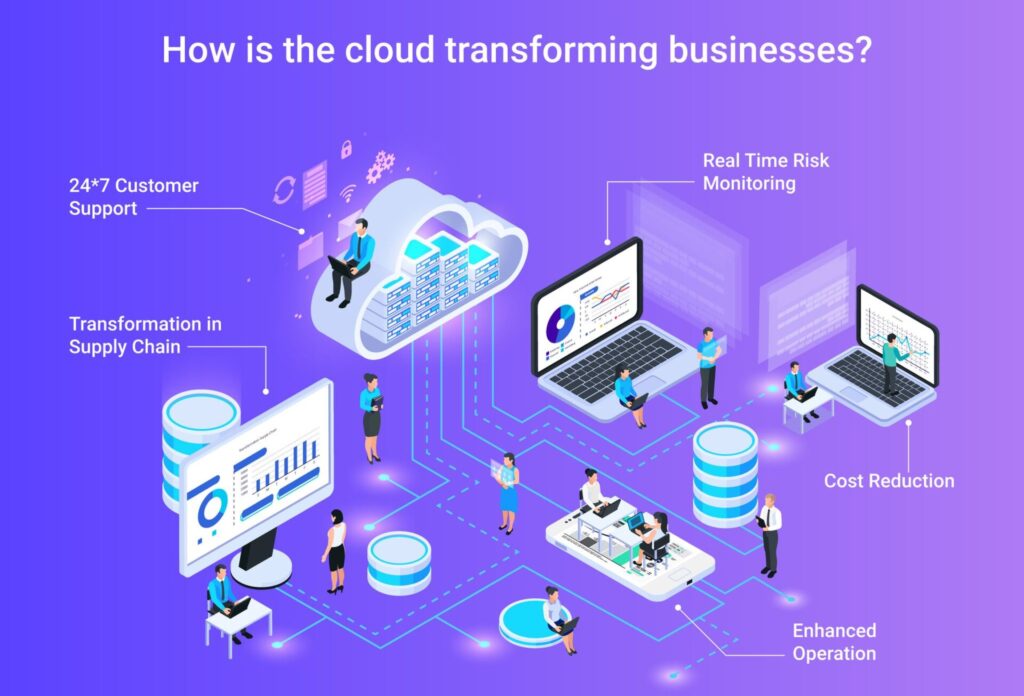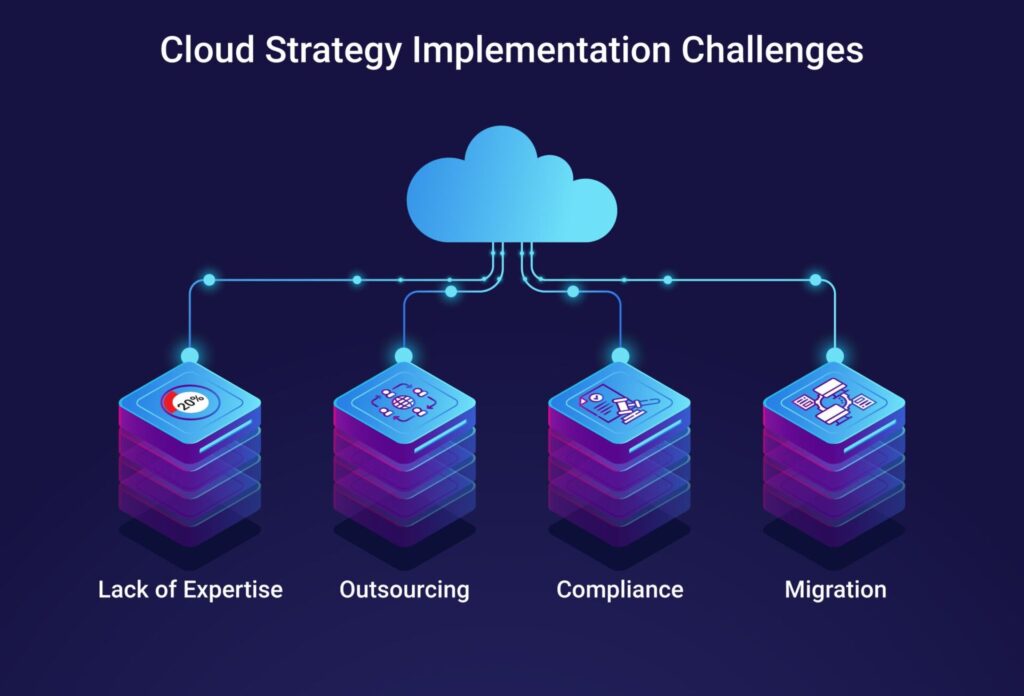Cloud technology has created opportunities to reach new markets and customers and reframe business evolution. As per Gartner, by 2025, over 95% of new digital workloads will be deployed on cloud-native platforms. So companies are constantly reinventing themselves to stay ahead of the curve.
But what if we don’t adopt the cloud in business?
Cloud innovation is accelerating at an unprecedented rate and reshaping the business landscape. The cloud helps organizations match the evolution speed not just to remain in the competition but to survive in the market, implying that you cannot afford to ignore the cloud!
This article will explore how the cloud is reframing business evolution and its benefits in business.
How is the cloud transforming businesses?

The cloud is a game-changer. It’s helping businesses become more agile, productive, and efficient. And it’s giving them the ability to scale their operations up or down as needed. For clarity, here are just a few of the ways the cloud is transforming the business sector:
1.Enhanced Operations
With cloud computing, businesses of any size can move part or all of their operations from a local network to the cloud platform. This provides easy access to various facilities, such as data storage and processing.
Usually, cloud computing service providers have a strong support team that can assist users through real-time communication. Such operations pave the way for the first step of business evolution.
2.Real-Time Risk Monitoring
Outdated systems are no longer reliable for monitoring risks or sustaining operations. Cloud computing has helped transform operations with solutions that drive real-time monitoring. For example, cloud-based tools like Google Cloud Operations, Microsoft Azure Monitor, and Amazon CloudWatch provide real-time views that help monitor network traffic.
3.Cost Reduction
a) One of the primary business goals is to reduce IT costs. Businesses that leverage the services of cloud computing providers save money because they don’t have to set up their infrastructure or hire additional in-house IT professionals. For example, Amazon Web Service (AWS) provides a pay-as-you-go pricing model. This platform significantly helps in reducing and optimizing IT costs.
b) Furthermore, the cloud allows businesses to put more money into other vital areas that need improvement.
How?
Cloud-based systems facilitate businesses with agility and flexibility by making IT operations simpler and easier to manage. With fewer complex business processes and simplified IT operations, companies can see increased employee productivity and a more remarkable ability to meet customer demands.
In other words, businesses can become more innovative and agile with increased productivity, efficiency, and flexibility. This makes it easier for them to adapt to changes and respond quickly to new opportunities.
According to PWC US Cloud Business Survey in 2021,
● 74% of business leaders are engaged in cloud strategy
● 56% of executives see the cloud as a strategic platform for growth and innovation
● Moreover, companies have significantly reduced costs (typically from 8% to 20%)
dashboards.
4. 24*7 Customer Support
Today, cloud computing providers have stepped up their game by offering an array of support options for businesses to choose from. In addition to the traditional telephone service, companies can now opt for AI-powered chatbots that can interact with customers just like humans.
Given that most cloud computing providers offer impressive bandwidth, it facilitates improved communications, allowing a firm’s customer support team to address customer requests swiftly every day.
5. Transformation in Supply chain
For supply chain managers, the cloud allows you to monitor your product across its life cycle closely, from when it’s manufactured until it reaches the customer. Also, the chances of goods or products getting misplaced during transportation are minimal because cloud-based supply chain management tracks and locates a shipment at every stage of transport. For example, Techwave’s SUPPLYVU™ platform unifies end-to-end business processes considering the constant changes in the supply chain needs of modern enterprises.
Challenges while implementing a cloud strategy in business growth
Cloud adoption comes with its set of challenges. However, the benefits of cloud computing are too vast to consider a few roadblocks as their deciding factors, particularly when you can easily overcome them if addressed efficiently and on time. Also, an expert cloud-managed service provider can ensure that an organization’s cloud implementation efforts are successful. Below are a few challenges that usually crop up with a cloud adoption strategy across all-size businesses and industries.

1.Lack of expertise
Cloud technologies are constantly evolving, and companies are under increasing pressure to adopt them. However, many organizations may lack the resources and expertise to keep up with the latest tools and skills. This might lead to challenges like workloads on the system, and the business evolution goal can take a backseat. The IT and development staff must be aware of up-to-date technologies and focus on learning and skill development to mitigate such challenges. Cloudreach – an ATOS company leading multi-cloud services provider- released new data on March 22, 2022, highlighting the latest cloud technology trends. The data underscores the impact the cloud skills gap is having on businesses. More than 70% of surveyed IT leaders internationally saw the skills gap as an urgent concern. More than half of respondents claimed it either slowed them down (46%) or posed an existential crisis to the company (9%). The study unambiguously indicates that IT firms must train their staff by providing them with the latest tools and updated cloud technologies.
2. Outsourcing challenges
● Cloud storage security issues – The market is overcrowded with the presence of several cloud providers. But some providers lack expertise in some services. Cloud storage security issues can arise from conflicting and overly complex security controls. A cloud security engineer is often required to implement these controls. Organizations can address the storage issues in two ways: by using a cloud storage solution that requires customers to set up basic security controls, such as AWS S3 buckets, or by using a good cloud provider that shoulders the responsibility for data storage security.
● No guarantee of service availability – Some cloud vendors may be unwilling to provide any guarantee around service availability, which is understandable given the market volatility. However, this presents a significant concern for any company dependent on access to its data. You must negotiate appropriate service levels and conduct due diligence on the cloud vendor’s technical infrastructure to gain confidence that the vendor can ensure proper access to and availability of data.
● Data Security – Outsourcing data to the cloud can put clients’ data at risk. For example, in August 2021, wiz.io detected a vulnerability in Microsoft’s Azure platform. The vulnerability allowed Azure users to gain full admin access (read, write, delete) to another customer’s Cosmos DB instance without authorization. The exposure impacted thousands of organizations, including numerous Fortune 500 companies. Microsoft notified over 30% of Cosmos DB customers about the potential security breach.
However, Microsoft’s security team took quick action to fix the problem and disabled the vulnerable feature. Microsoft advised customers to regenerate the Cosmos DB Primary Keys to mitigate the risk. The company is taking extra precautions by updating its threat model and investing in additional monitoring to detect unauthorized data access. Third-party vendors may pose many challenges, but to choose the right one, you must thoroughly vet them for your security concerns.
3.Compliance Concerns
With data compliance in the cloud, organizations face a unique set of challenges that also hinders business evolution. Enterprises must implement necessary steps to enforce compliance in the cloud, such as selecting the right compliance framework like HIPAA, FedRAMP, and PCI DSS. They must ensure that their data is adequately secured and can meet all relevant regulations.
4. Migration Strategy
Many leading companies struggle to migrate their applications to the cloud, and most are facing extreme difficulty due to projects being over budget and deadlines. A good cloud provider who can provide seamless migration services to the cloud resolves such challenges. For example, ideal partners like IBM Cloud Migration Services are skilled at migrating your workloads on the cloud using a built-in automation technique and a cost-effective strategy.
What overarching factors make the cloud an integral part of business evolution for all-size organizations?
These factors are what distinguish cloud capabilities and the added benefits as the most sought-after business evolution strategies:
● Suitable for any business – Cloud computing is an excellent way for businesses of all sizes to access powerful hardware and software. This can be a game changer for small businesses because it allows them to use tools that would otherwise be out of their budget.
And for big corporations, cloud computing can help streamline workflows and give them a more flexible approach to business evolution.
● Storage – Cloud data storage has become increasingly popular for its many benefits. Cloud storage systems allow you to access your data from any internet-connected location or device.
With cloud storage, you can share and sync files securely across devices. Some popular cloud storage services include Dropbox, Microsoft OneDrive, and Google Drive.
● Security/Secure Applications – Cloud-based security solutions can help secure applications by providing services like security coverage, including firewall protection, intrusion detection and prevention, and data loss prevention.
● Access to path-breaking innovations that support business growth – Cloud acts as an innovation catalyst for business growth. Cloud opens up countless opportunities with technologies like machine learning, DevOps, APIs, microservices, predictive analytics, and bots to further innovate and make the most of the information businesses store. It offers a new set of advanced tools that allows any business in any industry to truly innovate and disrupt.
Conclusion
Large businesses have adopted cloud technology, and they’re experiencing the success they’ve always wanted. However, tech leaders are often in a dilemma over how to embrace the cloud, given the complexity and overwhelming task of strategizing without affecting existing business productivity. But there’s hope! An expert third-party managed cloud services provider can efficiently navigate the challenges and consequential psychological pressures of evolving into a well-equipped cloud-driven company.



